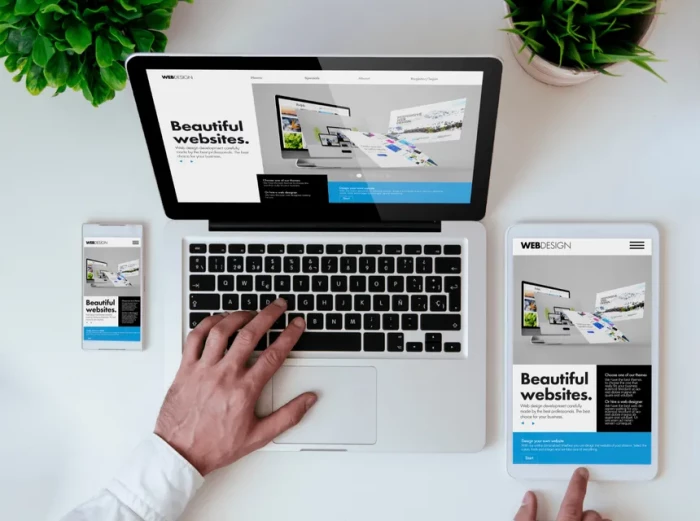Table of Content
AI is moving fast from being just an idea to something people use every day. In web design, it changes how websites look, work, and react. Pages, buttons, and even clicking or scrolling are now guided by smart systems instead of only fixed choices. Below, we explain how AI design works, how companies already use it, and why these tools will build the websites of the future much faster than old design methods.
From Static Pages to Intelligent Design

In the past, websites were like books with pages that never changed, giving all visitors the same exact message. Companies also had to spend time updating them one by one. Modern AI tools generate layouts, test variations, and optimize performance without constant human oversight.
Companies no longer wait for redesign cycles to adjust content. Instead, systems track clicks, navigation paths, and patterns, then refine design choices automatically to keep users engaged.
This change also influences how businesses present their brand online. Automated systems handle visual balance, suggest interactive features, and adapt to different devices instantly. However, human judgment remains essential to ensure these automated decisions still reflect company values.
In this context, web design Richmond becomes a smart investment in building stronger, future-ready digital experiences that attract customers, adapt quickly to change, and deliver measurable long-term growth for companies competing in crowded online markets today.
Personalization at Scale
Websites today can adjust to each visitor instead of showing everyone the same page. By noticing browsing habits, location, and preferences, they display content, images, or layouts that feel more personal without constant manual updates from design teams, a shift already highlighted in AI personalization research by IBM.
This way, a customer searching for software tutorials may be shown guides immediately, while someone interested in pricing gets a clear comparison. This efficiency reduces friction, keeps attention longer, and supports higher conversion rates.
However, the real advantage here is scale. Doing changes by hand for thousands of visitors would be impossible. But AI makes it easy, giving each person a special experience that updates quickly, much like minimal subtitles enhancing communication online.
However, this only works if there is a clear plan. Businesses must decide what they want visitors to do, like sign up, purchase, or return later. AI handles the large numbers, but clear goals make sure those changes truly help the company succeed.
AI and SEO-Friendly Web Design
Personalized websites hold attention, but visibility starts with being found. That’s where AI supports SEO. By tracking performance in real time, detecting issues, and suggesting targeted fixes, these systems help businesses appear higher in search results without constant manual work from teams.
Another benefit is content optimization. AI tools look at keywords, study other websites, and suggest terms people search for. They also improve headlines, meta descriptions, and internal linking structures, helping brands create authentic AI content that’s easy for readers to engage with and optimized for search engines.
However, using only machines won’t always work. If companies put too many keywords, it can hurt them instead of helping. That’s why human judgement is needed. People make sure the website feels natural, clear, and still matches the company’s goals.
Besides maintaining balance, AI also helps uncover search opportunities humans might miss. It checks thousands of searches and spots new trends or forgotten keyword phrases. This gives businesses the change to reach people sooner and win traffic their competitors are not yet noticing.
Challenges and Ethical Considerations
AI helps websites work better and appear quicker in searches, yet it can also cause issues. Using automation too much may remove the company’s voice. A website might look neat but seem empty, missing trust and warmth people want, as seen in AI design trends.
Another issue is bias in AI choices. When trained with small or unfair data, the system might design sites that only match certain groups. Others may feel ignored. To avoid this, companies should check results often to keep websites fair and open.
Privacy is another key concern. AI-powered personalization depends on data collection, but without care this can cause mistrust. Companies should use simple consent steps, open policies, and safe data storage. This builds trust while still enjoying the helpful insights AI provides for online growth.
Preparing for the Future of AI in Web Design
Addressing challenges and ethics is only part of the picture. To really grow, companies must also prepare for what’s coming. AI is moving fast, and those that plan early with workspaces ready for change will gain the greatest advantages from this digital shift.
Preparation starts with people. Training workers to use AI tools helps them see when machines should help and when human judgment matters most. Employees who can balance these two approaches will protect the company’s style while still working faster and smarter overall.
Technology choices are also important. Companies should review which AI systems support their goals, whether for tracking data, personalizing websites, or helping design. Picking the right platforms saves money, avoids mistakes, and ensures the business can keep up as industry standards change.
Endnote
Preparing for the future of websites is more than just adding new features. Companies must use AI carefully to improve speed, protect their brand look, and create sites that adjust fast but still stay useful and meaningful to what customers want over time. Companies investing in AI-driven design today secure long-term growth opportunities, smoother experiences for users, and stronger trust from their audiences.


